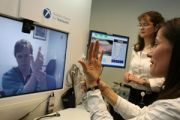Expanding Access to Acute Stroke Care through Telemedicine
Study shows that the use of telemedicine by primary stroke centers and other hospitals increases access to specialized stroke care for patients living in rural and medically underserved areas.

New Orleans — October 13, 2013 — At a poster session at the Annual Meeting of the American Neurological Association, Tzu-Ching Wu, MD, presented data on the role of telemedicine in acute stroke care in Texas. Wu, first author on the project, is an assistant professor of neurology at the University of Texas Medical Center.
In a large, rural state like Texas, not all people have access to a primary stroke center, a hospital that specializes in treating strokes. To achieve accreditation as a primary stroke center, a hospital has to meet stringent qualifications and patient outcomes. Care at such centers has been shown to improve patient outcomes, but not every hospital is going to be able to achieve that status. “There are a lot of hospitals that are able to treat these patients with the aid of telemedicine but aren’t designated primary stroke centers. The goal is to treat those patients early so they get tissue plasminogen activator (tPA), the only medicine which has been proven beneficial,” said Wu.
Currently there is no registry or other simple way of determining what areas are partly served by telemedicine. Researchers in the present study aimed to examine how telemedicine might have expanded access to acute stroke care in Texas. Due to its relatively straightforward nature, it is believed that acute stroke care represents one of the most prevalent forms of telemedicine.
Wu added, “If you’re a hospital with a CT center and able to draw labs… you can give tPA, but people aren’t comfortable with that because they don’t have the expertise. Telemedicine provides access to that expertise to really help staff that is unaware or uncomfortable giving TPA on their own.”
The research team surveyed 395 Texas hospitals with acute care facilities and placed them into one of four categories. Primary stroke centers that used telemedicine composed one category (n=22); Primary stroke centers that did not make use of telemedicine went in another group (n=81). The third group included hospitals that were not primary stroke centers but that did use telemedicine for their acute stroke care (n=26). The final group included the non-primary stroke centers who did not use telemedicine (n=266).
On analysis, 75.4 percent of Texans had access to a stand-alone primary stroke center within an hour’s drive by ambulance. Adding primary stroke center that utilized telemedicine increased access by another 6.5 percent. Another 2 percent of the population gained access to specialized stroke care through a hospital not specialized as a stroke center, but which used telemedicine. This left about 16 percent of the population without access to specialized acute stroke care. About 62 percent of the population of Texas has access to more than one center specializing in stroke care within an hour’s drive within the state.
In the present study, the use of telemedicine increased access to stroke care for more than two million Texans (over 10 percent of the population). Thus, telemedicine may serve as an avenue to provide more people with access to specialized stroke care, especially people in rural and medically underserved areas. It may also provide a way to optimize acute stroke care interventions while conserving existing resources.